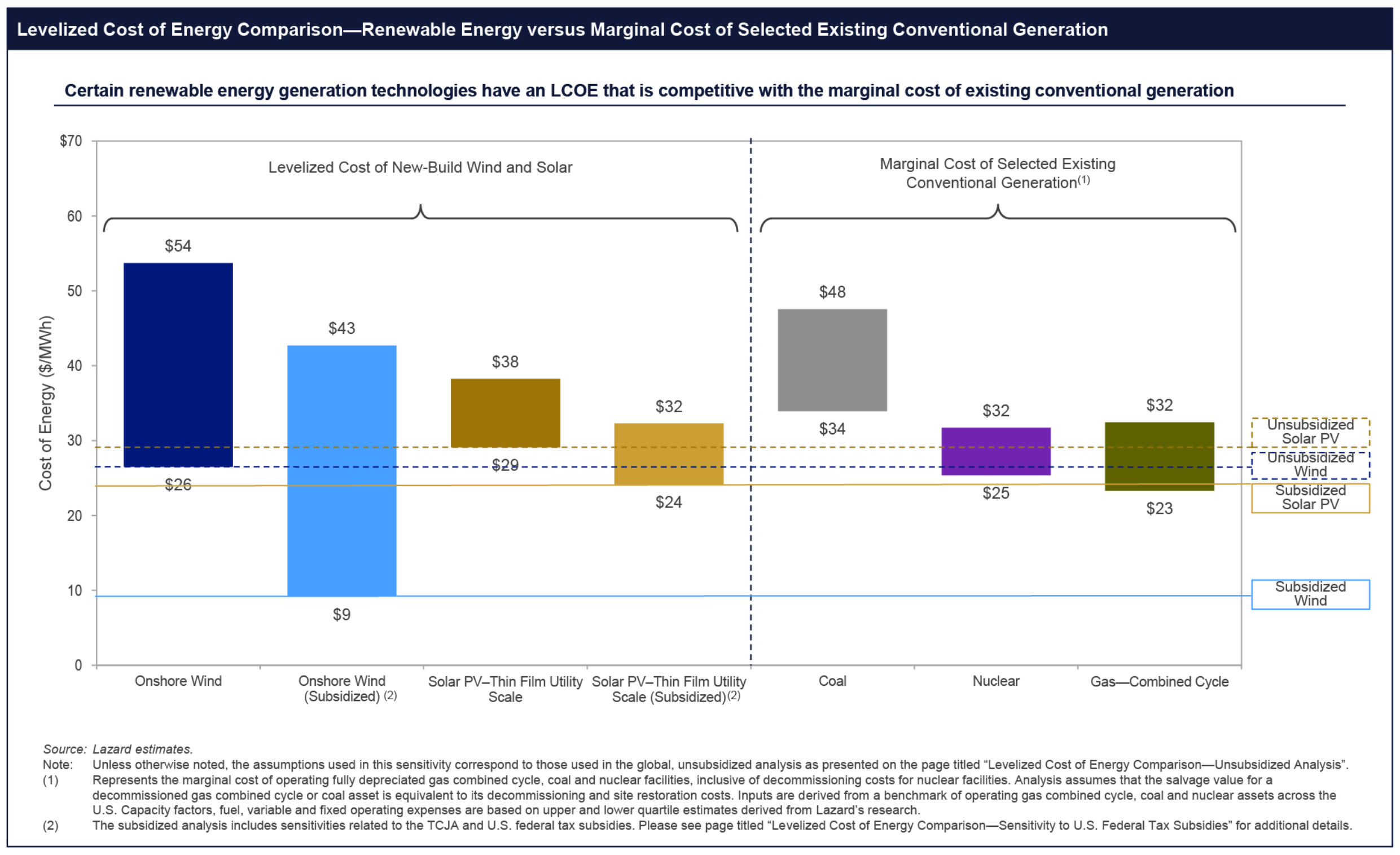November 15th, 2020 by Zachary Shahan
We recently saw the International Energy Agency (IEA) report that solar power offers the cheapest electricity in history. That was a global report. A US-focused report from Lazard recently reported something similar. The highly regarded energy analysts showed that wind and solar offer the cheapest electricity in the country, even significantly undercutting natural gas combined cycle power plants now. But that’s only half of it.
Solar & Wind Energy Are Cheaper — Much Cheaper
Historically, when we write about such reports, we — and the analysts we’re referencing — are comparing estimated electricity costs from new power plants. However, for at least a few of these reports, Lazard has been including average electricity cost from already built power plants — just the operational costs (the brown diamonds in the chart below). The latest report shows that new wind and solar power plants can even provide electricity more cheaply than existing, in-operation natural gas, coal, and nuclear power plants! This is where things get interesting.
We’re at a kind of crossover point right now, but if solar and wind continue to come down in cost while the others stay the same or get more expensive, there will be serious pressure to retire fossil and nuclear power plants early and scale up wind and solar power production even faster. Why pay more for electricity from old, dirty power plants when you can get it more cheaply from new, clean, green electricity?

Chart courtesy Lazard.
(Side notes: the light blue diamond is for offshore wind, the green diamond captures the price with 20% green hydrogen used in the natural gas combined cycle power plant, and the dark blue diamond captures the price with 20% “blue hydrogen” used in the natural gas combined cycle power plant.)
Here’s another chart looking at electricity costs from new wind and solar power plants versus marginal costs from existing fossil and nuclear power plants:
Chart courtesy Lazard.
Not to bad.
Much more is available in the Lazard report examining levelized cost of electricity (LCOE) — aka the average cost of electricity production from a power plant across an estimated plant lifetime, or 20 years — including shorter comparisons in several other nations. The short story, though, is that solar and wind are much cheaper basically everywhere.
Powering the World with 100% Renewable Energy
Mark Z. Jacobson at Stanford University and Mark A. Delucchi, affiliated with UC Berkeley, UC Davis, and Lawrence Berkeley National Laboratory, have been telling us for many years that wind, water, and solar can power the world — and should power the world. In a report published in late December 2019, they and several other researchers published a highly detailed plan of how 143 different countries could be power by these renewable energy sources, including a close look at what is needed and what’s expected to be available throughout the day on each day of the year.
The researchers call these analyses “Green New Deal all-sector energy roadmaps.” They look at expected job creation, grid stability changes, social cost savings, and energy cost savings from a fully shift to wind, water, and solar by 2050.
Overall, this clean new world of wind, water, and solar (WWS) “reduces energy needs by 57.1%, energy costs by 61%, and social costs by 91%.” The upfront costs total $73 trillion, but the long-term savings are well worth it. The WWS focus will also create an estimated 28.6 million more jobs than under a business as usual (BAU) scenario.
“This paper evaluates Green New Deal solutions to global warming, air pollution, and energy insecurity for 143 countries. The solutions involve transitioning all energy to 100% clean, renewable wind-water-solar (WWS) energy, efficiency, and storage. WWS reduces global energy needs by 57.1%, energy costs by 61%, and social (private plus health plus climate) costs by 91% while avoiding blackouts, creating millions more jobs than lost and requiring little land. Thus, 100% WWS needs less energy, costs less, and creates more jobs than current energy.”
Wind & Sunshine — Cheaper, Cheaper, Cheaper
Analysis after analysis, study after study, the message is the same — busting out the solar and the wind like we just won an NBA three-peat is the cheapest way to go. Whether talking social costs, environmental costs, or just simply energy costs, transforming wind and sunshine into electricity will save humans billions or trillions of dollars.
Now, the story is shifting from cheaper to much cheaper. Perhaps we will get a lot of stories of early fossil power plant retirements in 2021 and beyond.
Appreciate CleanTechnica’s originality? Consider becoming a CleanTechnica member, supporter, or ambassador — or a patron on Patreon.
Sign up for our free daily newsletter or weekly newsletter to never miss a story.
Have a tip for CleanTechnica, want to advertise, or want to suggest a guest for our CleanTech Talk podcast? Contact us here.




